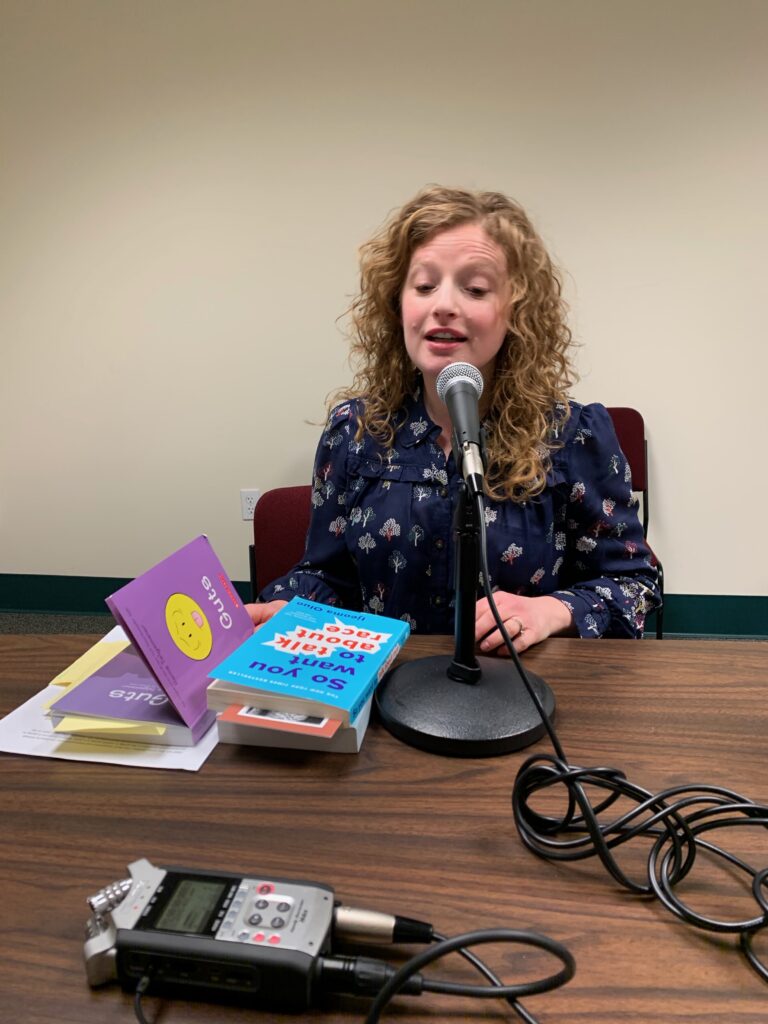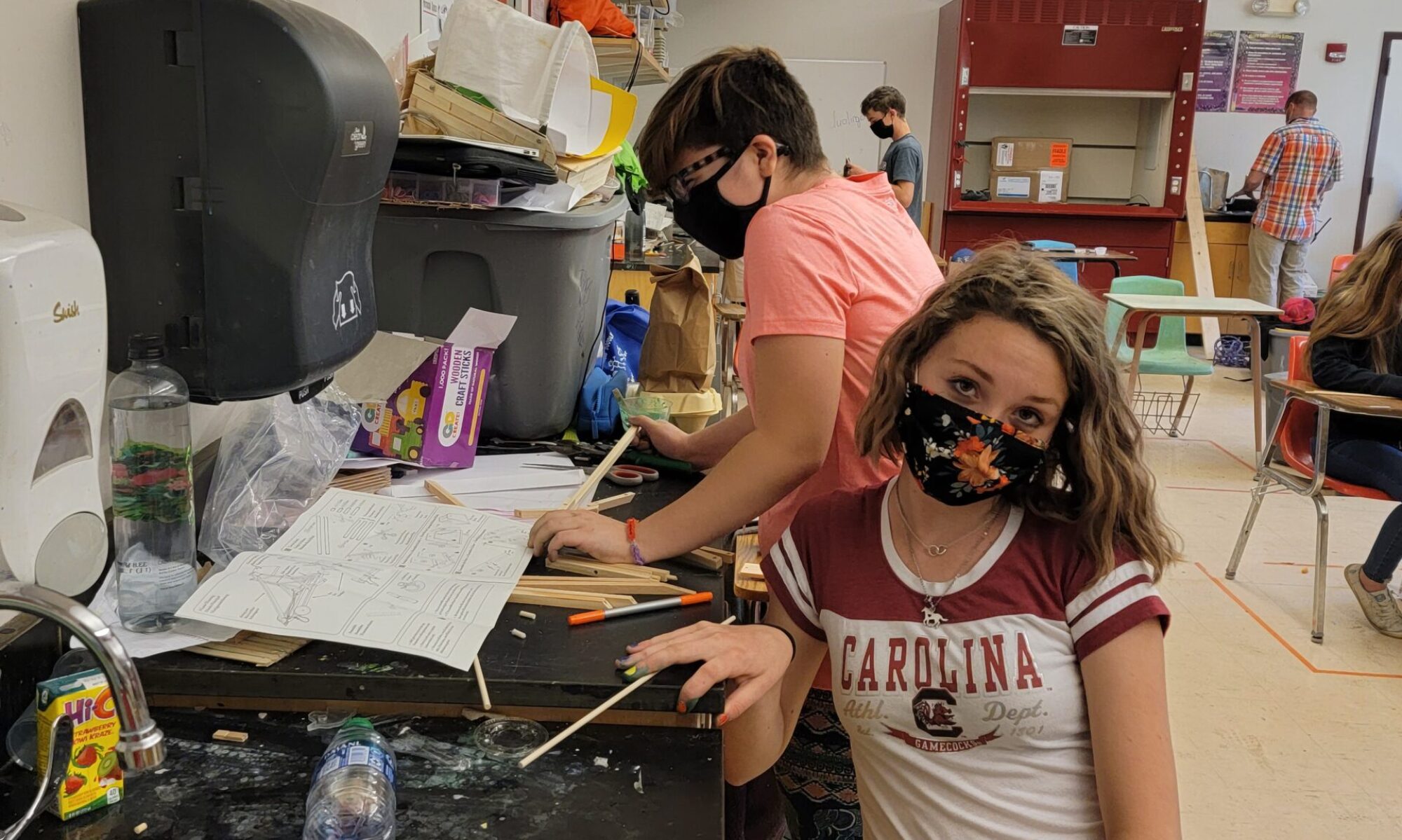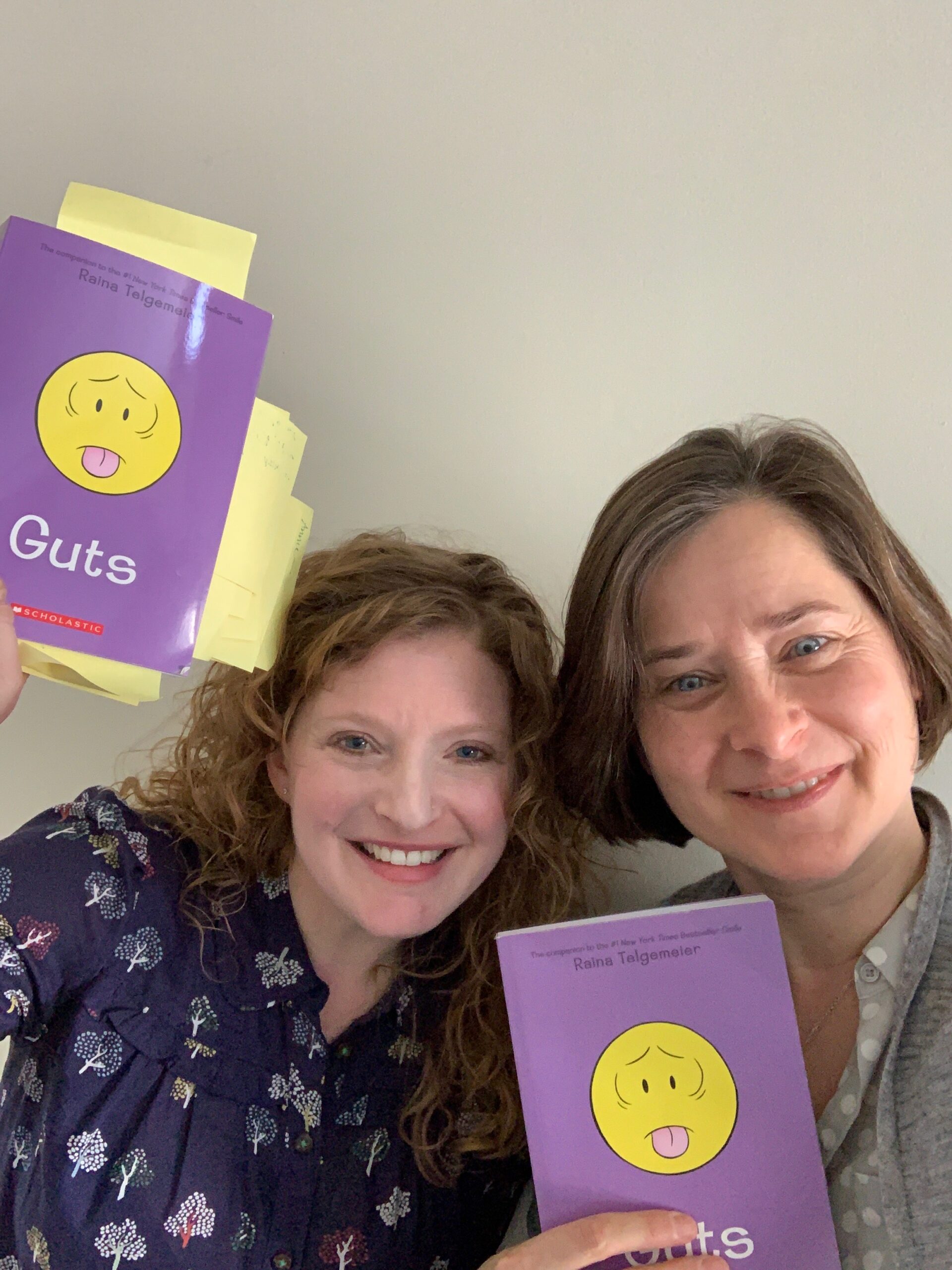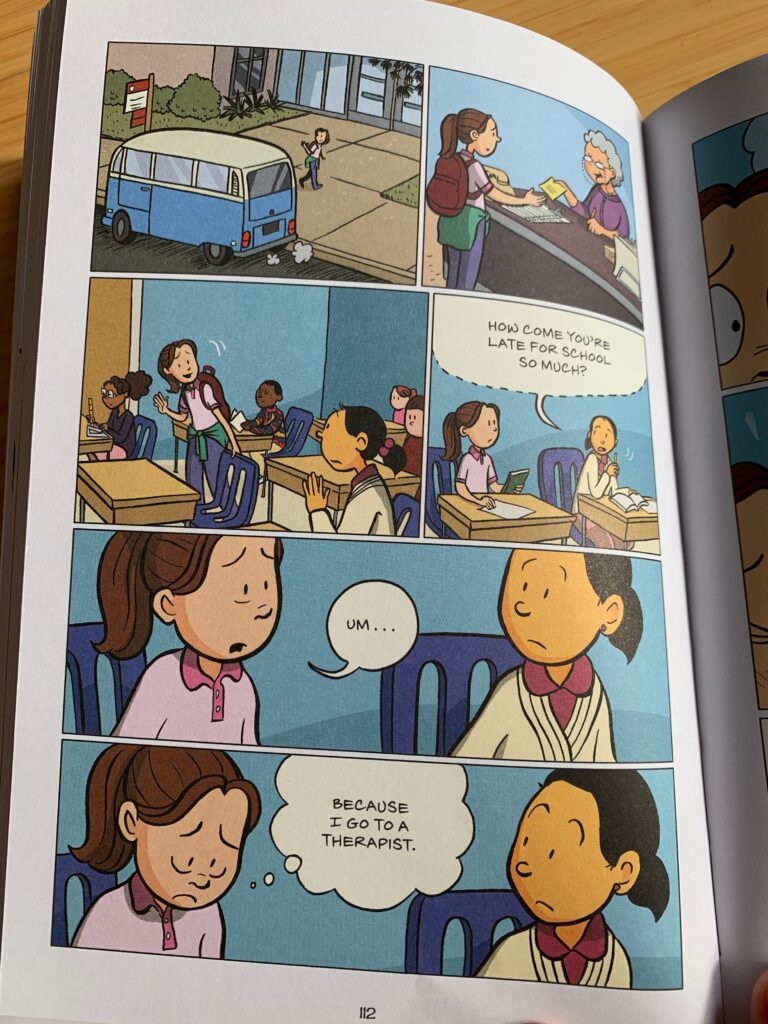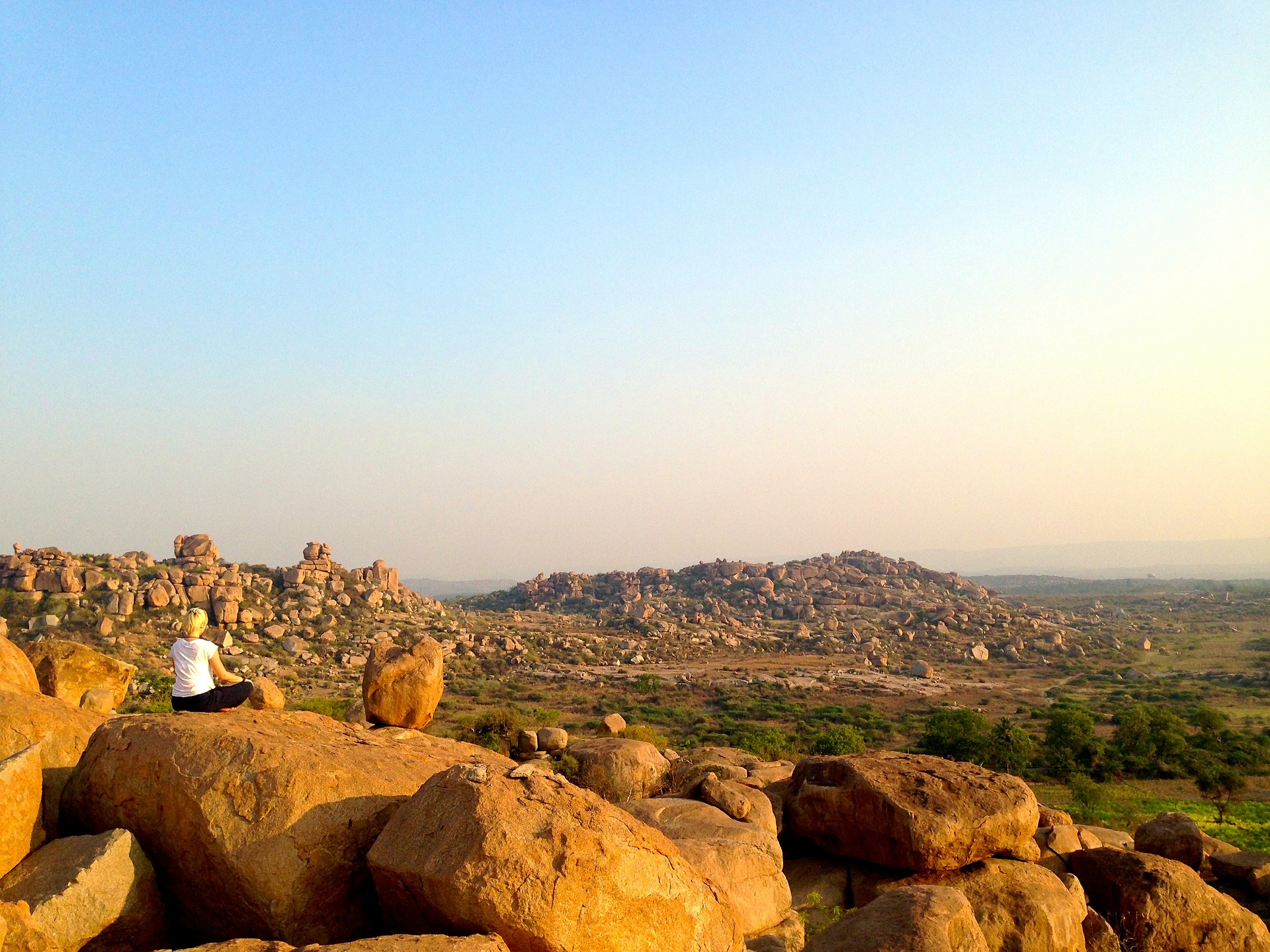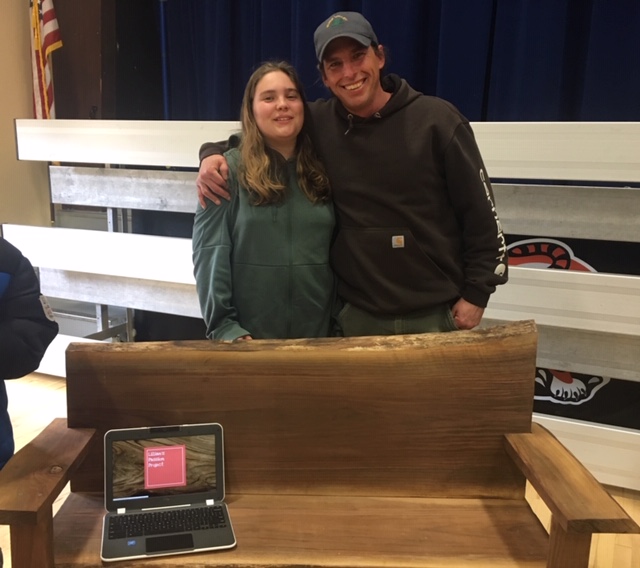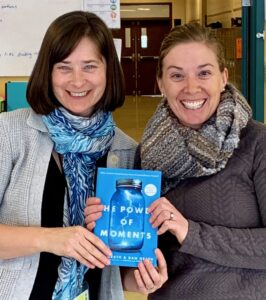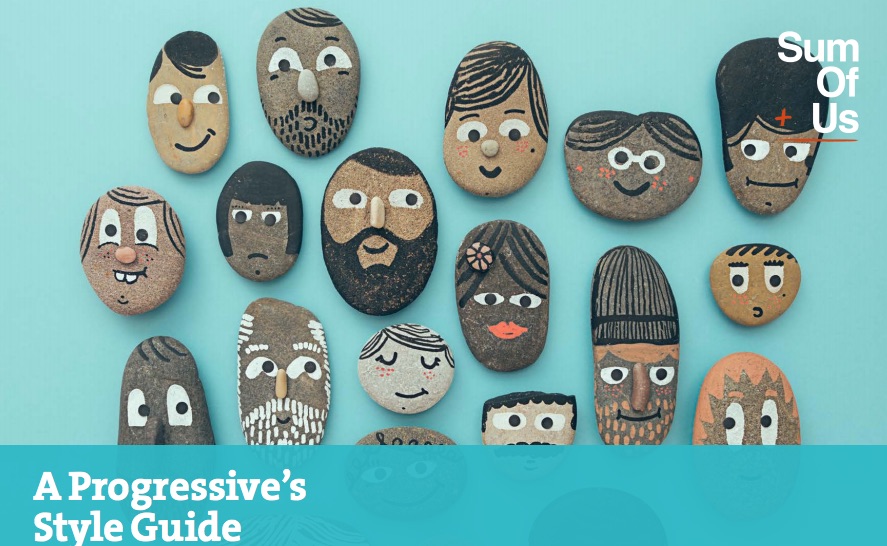I’m Jeanie Phillips, and welcome back to #vted Reads, the podcast for, by and with Vermont educators.
And I? Am still here. As are you.
Now, we recorded this episode with our lovely friend Lindsey Halman back in February 2020, a time that at this point feels almost like a long-ago Camelot, or perhaps as the late great Hunter S. Thompson put it, “that place where the wave finally broke, and rolled back.” It’s the end of March — same year! — and so much about what we do, and how, and where, has changed.
But not the why.
In this episode, we talk about a book called Guts by Raina Telgemeier, and a lot of what we discuss centers around what the main character learns about herself and her body’s reactions to anxiety.
So first and foremost: if you’re not in a space for that right now, I *completely* understand. Put it down. Go meditate. Bake cookies. Take a walk with a child in nature. Listen to 99% Invisible instead.
But for everyone who’s sticking around (and those of you who eventually make it back from the nature walk), thank you. Thank you for being around, and thank you for staying around. It’s okay to feel whatever you’re feeling right now. It’s okay to be overwhelmed, it’s okay to be anxious. But if nothing else, this period in our history has shown us that when the going gets tough, #vted gets tougher. (Y’all commandeered *the buses* for delivering food! The buses!)
Anyway, the work has always been hard, and now it’s just hard in new ways. Ways we’ll find our way around together.
Now: let’s chat.
Jeanie Phillips: I’m Jeanie Phillips and welcome to #vted Reads. We’re here to talk books for educators, by educators, and with educators. Today, I’m with Lindsey Halman and we’ll be talking about Guts by Raina Telgemeier. Thanks for joining me, Lindsey. Tell us a little bit about who you are and what you do.
Lindsey Halman: Sure. Thanks, Jeanie, for having me. I was a middle level educator for 15 years and my heart is always with young adolescents Those were my people. And I currently am the executive director of Unleashing the Power of Partnership for Learning –also known as Up for Learning. So I have the privilege of working with schools across Vermont.
Jeanie: Excellent. Well, I’m so excited to have you on the podcast. And you brought this book to my attention: Guts. Although, as school librarian who’s worked K-6 and 7-12, I have to say Raina Telgemeier has been a big hit with my previous students for many years. And her books were always hard to keep on the shelves. Always books I had to have multiple copies of. But I’m really excited to talk about this one. Like Smile and some of her other books it’s a memoir, told in comic or graphic form. And I wondered if you introduce us to the Raina in this specific book.
Lindsey: Sure. So, I should also I mention that I’m a parent. That’s probably the most important piece! Parent of a nine year old. o, this book really resonated with me and my daughter as we read it together. So, I just wanted put that piece in there. And so Raina, the author and Raina, the character, we see her between 4th and 5th grade in the story. So, she is nine. And she describes herself as nervous, self-conscious, shy and quiet. Except when she’s with her close friends, Jane and Nicole. And I would say that that’s maybe what people when she’s in school are those qualities of just maybe being shy and quiet. But she has so much more to her. She’s a Girl Scout. She’s an artist. She loves to draw, create comics.
She’s an older sibling; she has two younger siblings. She lives in an apartment with a family of five. And her family feels very well connected and supportive of one another, both in the sense of they live in a tight space and so they’re sharing and in close quarters. But also they are sharing and in close quarters as in their relationships. So, they have very supportive relationships with one another.
Jeanie: Yeah. I love that you bring out that she may appear one way in school. But then in her family and in her friendships outside of school she shows up in a different way.
Lindsey: Yeah. She even says like, in the book on page 11, she says like: “I was a nervous kid, self-conscious, shy, quiet. Most of the time.” And I think a lot of young adolescents, including myself when I was that age, could really connect with that, because you have your people. And her people are Jane and Nicole. And at lunch time, at recess, when they’re laughing and sharing food and reading comics together, that’s where she kind of can take off that armor and be her true self. That’s when knows that her people love her for who she is.
Jeanie: Yeah. Yesterday morning I read this piece from The Atlantic about the importance of middle school friendships. Why they matter. And that really makes me think of that article and the way middle school friendships impact our resilience and our capacity to learn. And the way our brain functions, especially for young adolescents.
Lindsey: Absolutely. I mean, I think it’s, both you get the feedback from your friends: you can try out who you are and who you want to be, and get that feedback. Just both forming your identity and getting the feedback. But also then, you know, having those close connections where you feel like there is an outlet for those thoughts and feelings. Thoughts and feelings you can’t share with any other outlet. And I remember that as a young adolescent, and I now can see it as a parent. Just the different ways that we show up both in our different parts of our lives and where our true authentic self comes out.
Jeanie: Well, speaking of authenticity, this is just such a middle school book. It’s set in middle school — early middle school really, but there’s all these changes and transitions and gross-out jokes and friend drama. And I wondered if to you, as a middle school teacher, somebody who’s been a long time in middle school, if it feels authentic to you?
Lindsey: Yeah. It definitely did. So, number one it felt super authentic to me. In the book on page eight, she says: “Fourth grade was pretty much one long gross-out contest.” And I just remember that experience. And I can reflect on what my daughter is experiencing now. But I also can reflect on what they’re looking at. Like, there’s a group of kids in the cafeteria looking at, it looks like Garbage Pail Kids. And so I feel like maybe Raina and I might be around the same age! And so I can kind of relate to some of the things that she incorporated here too.
So absolutely. Like, I’ve fourth through eight grade in my career as an educator and I think she really captured it in many ways. They’re on the cusp of puberty and they’re just kind of figuring out, like, “Is it still cool to do this?”
And there’s also that sense of like wanting to be friends with somebody but not knowing how to do that.
I think we see that sometimes with Michelle, who sometimes says things that can rub Raina the wrong way and make her feel like maybe Michelle doesn’t care for her. But in all reality it seems like at the end it’s really trying to figure out who are your people and how do you connect with each other and how do get people’s attention and–
Jeanie: Michelle is a classmate.
Lindsey: Michelle is a classmate. Yes We find out at the end that Michelle is also dealing with her own physical ailment as well. And that’s been hard for her and no one knows that. We learn that we all have our stories. We find out that Michelle’s in the hospital because she had surgery on her intestines.
You learn that everyone has their thing. Their story. People are all dealing with stuff. And we don’t always see it on the outside.
So, for Raina, this idea that she’s dealing with anxiety. It’s a real issue. And right at the time where she’s at, that’s where we start to see anxiety in our youth as well, coming to the surface. It’s right on the, you know, cusp of puberty where anxiety often really starts to show itself.
It starts to feel like: “What’s happening me? Because I was fine before when did all these things. And now, I have a hard time going to school because I’m worried I’m going to get sick” Or because I’m worried about standing in front of my peers and sharing information or a number of things. So the worries can start to consume young people. Just like for Michelle, it was physical ailment. And it was consuming her in a different way.
Jeanie: So, one of the things that came up really for me in reading this book is not only is anxiety emerging for some young people, right? And they’re dealing with that? They’re also just trying to identify it in the first place. It shows up in all of these different ways. And I think it’s so much harder to struggle with something that you don’t know what it is or you think it’s just figment of your imagination. Part of the process of maybe becoming less anxious is just naming it in the first place.
And so I wondered… I guess what that makes me think about is: how do we show up for young people when we are not sure what they are dealing with, they’re not sure what they are dealing with, anxiety looks like all these different things, it’s not really our job to diagnose them– And so, I guess I am just asking what’s the best way for us as adults to show up in classrooms with the potential of having anxious students?
Lindsey: Yes, I think that’s a great question. Statistically I think it’s one out of five young people have an anxiety disorder. We *all* have anxiety, it’s part of the primitive part of our brain. Worries are important to have because it helps us remove ourselves from dangerous situations, in our primitive brain. But it’s when the worries start to take over and impact our daily life, that it becomes a greater concern.
And just like you said Jeanie, it can manifest in so many different ways. I think what ends up happening is that, as adults, sometimes we are quick to jump to labels like, oh that’s a tension issues or that’s you know, resistance to work or that’s this or that’s that …and that’s not really okay.
Because as we see with Raina, it can look like so many things. It can look like avoidance. It can look like feeling sick. But it sure can manifest in a physical way.
It can also get in the way of relationships which I think we see that with Raina in her friendships, because it’s starting to consume her. So I think we need to be really careful as adults in recognizing that:
- there is a lot of young people in our classroom that are experiencing this and,
- that it’s going to look different for every individual.
Someone in my life once told me when someone has for instance diabetes, we know that they need to take care of themselves in a certain way.
The same thing for anxiety. If you have anxiety, a major part of your life is impacted by this particular, I don’t know if we call it illness or…
Jeanie: Condition.
Lindsey: Condition, right. And just like diabetes, you treat yourself in a certain way. You take care of yourself. We need to recognize there are ways we can get a handle on our anxiety, and support all of our students in that.
There is one thing when she begins therapy with her therapist Lauren and I really loved that relationship, because Lauren teaches her just basically her key mantra to her is: try. Because Raina says, there are all these thoughts in my heads and that manifest in all these feelings in my body. But sometimes articulating what it is that’s causing those thoughts and feelings is really hard. And Lauren coaches her in just this idea of try.
The other thing that I loved and this really connected me to a colleague and friend Anya Schaunessy, who does a lot of work with schools throughout Vermont. And thinking about a whole-school restorative approach. And mindfulness. She has her own poster, her own mantra — two feet one breath. If we can just, when we start to feel those feelings or think those thoughts, put our two feet on the ground and take a deep breath. You can feel a complete change in your body.
And that’s reflected in what Lauren shares with Raina as well. She just says put your two feet on the ground and take a deep breath. And Raina ends up sharing that with her classmate as a strategy at the end of the book as well.
Jeanie: This makes me think so much about how trauma-informed practice is good practice for every student…
Lindsey: Absolutely.
Jeanie: It feels like a mindfulness practice in the classroom. It’s good for every student even if we are doing it in a way to help our anxious students, our anxious learners.
I also was really interested in the relationship Raina has with her therapist, which is one of the ways that she is taking care of herself.
Jeanie: I am going to turn to pages 112 and 113 because there is a lot going on here. Jane says to Raina, how come you are late for school so much? And Raina to her close friends says, she thinks in her head because I go to therapist. And then she also imagines that Jane might say, why? Is something wrong with you? Are you crazy?
So, instead of having that because of that fear she says, I can’t tell you. Which puts a barrier in their friendship. But also that word, “crazy” gets thrown around a lot usually in ways that are insensitive or offensive to people with mental illnesses.
And so there is a lot going in here, her fear of telling somebody that she is seeing a therapist. This word that sort of is unkind and it’s used maybe and then also just like the stigma attached to being in therapy. And I wondered if we could just talk about that?
Lindsey: Yeah, I would love to. Well the first piece that comes to mind is that, here is her closest friend, her BFF, you know. The person that knows her better than anyone you know, of all of her peers and she can’t tell her this thing. It makes me think of like, okay if you broke your leg and you had to go to physical therapy? Or if you had, I don’t know physical illness, you needed to go to your pediatrician or your doctor, and someone asked you where you were? You would not hesitate to tell them.
So, it’s frustrating to me as both just a human and as an educator that there is such a stigma with therapy. And that this is most important organ in our body — our brains, right? And then there is so much going on and it impacts everything we do, and that we can’t just be opened about the idea that therapy is really important. Just like if I broke my leg and needed to learn how to use my leg in the proper way again so I could be as mobile as possible?
Therapy is essential for those that experience anxiety disorder.
And so, the idea of this word crazy also really doesn’t settle with me either Jeanie. Because what does that even mean? You know? And when we say people are crazy we have these pictures that come to mind that aren’t even accurate.
Jeanie: Okay. One of the things that I wonder about as a lover of books, as an avid reader is Raina is telling her memoir? And kind of imagine that that was the thought that she had, in that time, in that place, at that age. I’m not really criticizing her use of the word on the page necessarily; that might be her authentic experience.
But I’m also wondering about how we might talk to kids about why we might not want to use that word or how we might even talk towards those about why we may not want to use that word. And I think about, oh, the fabulous Rebecca Haslin talking about how a friend called her out — called her in — for using that word. She said, do you realize how often you use that word? And I have been noticing my own vocabulary.
Lindsey: Me too.
Jeanie: I use “guys” a lot and I am trying to stop that. And I have just tried to be more aware of the language I use and the impacted it might have regardless of my intent.
Lindsey: Yeah, absolutely. I agree with everything you just said. And I agree that also Raina probably, that’s the way she felt at the time. Like, I don’t think there is anything wrong with her putting this in her story at all. I don’t think it’s really important, to like have that there because that is the stigma that’s attached. And then you worry that that’s how people are labeled. Like, why are we giving folks labels that are not even accurate? And so, I think that it helps at the end: the girls at the sleepover party are sharing some really personal information. And it’s time for Raina to share and she puts it out there.
That feeling of like, okay, I can let, take off the mask and truly be authentic and real and show up. And she tells them that she goes to a therapist. And they are like, oh my parents go to a therapist. Oh, my brother goes to a therapist. And what happens in that scenario is it normalizes therapy, you know, the idea of going to a therapist. Which for those that experience anxiety really supports them in understanding that that is a normal feeling, that it’s okay.
And then, that’s one last thing that you have to worry about is being, once you start talking about it and being real with people, you start to realize that it allows other folks to be real, too. Like you. And I think with students we need to be having these conversations. We talk about all different other, you know, impacts on us as far as our health and well-being, but we keep for some reason, anxiety and depression as very taboo topics still in our society. And I just wonder how we can make them more accessible and just part of our natural vocabulary. Because if one in five student in our classrooms are showing up with an anxiety disorder? That’s a lot of folks in our classroom that might be having similar experiences to Raina did.
Jeanie: It makes me think about how shame thrives in the dark. Right? And talking about it brings it out to the light. And so, Raina has been carrying this shame that really – it’s a burden she need not have carried.
Lindsey: Right, there’s other burdens that she’s carrying. We all carry burden but shame is definitely not one of them. And once, I think that it feels like from the pages what I can feel for Raina is that once she was able to really share her story with her peers? It probably offers some light to her. You know, that lightness both in her body and in her way that she can walk through the world.
Jeanie: I think it’s really obvious to me now that it’s important for this book to exist in the world. And so, I think it was important for Raina Telgemeier to share her experience. But I also think it’s just important for those kids – those one in five that you keep mentioning to see themselves in this book. And I wondered if you wanted to talk about that?
Lindsey: Yeah, I really think we need more stories like this. And that is the beauty I think in many ways of Raina Telgemeier’s work is that, I just remember like you said, the books in the library because they were always on the table in my classrooms. I just remember all the copies of Smile and Sisters and now Guts. They’re always being carried around like these are essential text for young people because (a), they are accessible and (b), they really resonate in the sense that, hey I have had those feelings too.
And there’s like some takeaways as well! Like, okay so Raina worked through it in this way. Here’s some strategies, maybe these will work for me. And that, seeing yourself reflected on the pages, which I think is just the beauty of all books is like, it just gives you that connection that there’s other’s that are experiencing similar things. That you are not alone. That there is others that have these thoughts, feelings, experiences and it’s a way to share that.
So I feel really grateful to Raina Telgemeier for sharing her story. It’s not an easy story to share, as we know, when you are sharing your personal experiences. I think that this book could potentially become a really important one for young adolescents in the sense that it allows them to have open conversations about anxiety. And other mental disorders or illnesses that impact themselves and their peers.
Jeanie: Yeah. I think we both are unanimous in our agreement about that. Now, there is another book that Raina Telgemeier has written more recently that maybe *isn’t* the story she should have told. And that’s this book, Ghost. It has encountered some really critical feedback. And it concerns me because I suspect it’s on the shelves in our Vermont schools because once you have an author like Raina Telgemeier, you buy every book.
So, I want to talk a little bit about Ghost. And why we might want to think about its place in our collections, and how we might to students about it. You’ve read Ghost recently?
Lindsey: I have, yes. And when we had talked about this conversation around Guts, we had both agreed that there is, you know, that that was something that would be really important to center in this conversation as well. When I went back to do some further research preparing for today, I stumbled upon a PSA that group of students, I think they were fifth and sixth grader, created at their school on Ghost and the idea of cultural appropriation.
Jeanie: Before we talk about their PSA, could we just give a little over view of Ghost. I think it’s about two sisters who move to the coast of California. And their neighbor. Do you want to pick this up?
Lindsey: Yeah. One of the sisters has cystic fibrosis. And so, the climate where they move is much more – is a much healthier climate for her to be in as far as her ability to move throughout her life.
Jeanie: So, the two sisters’ move to the coast of California and their neighbor Carlos become a friend and they start exploring with him. Then he takes them to a nearby Spanish mission. And that’s where the story really starts to go array *despite* Telgemeier’s best intentions.
Lindsey: Yes. So, I think what ends up happening young people like to explore kind of the spooky side of things and the mysterious part of life. But what ends up happening is that there’s a lot of exploration around Dia de los Muertos and the interpretation of what that is becomes very much like the American Halloween — which it really is *not*. And there was a lot of feedback to Raina and her book around the fact that it was really not representing both the holiday itself and how it’s celebrated and/or experience.
Jeanie: One of the things that interested me — and Debbie Reese, in particular, has a really wonderful post about it — is that mission are colonial institutions that were designed to do a very specific things. They were designed to “convert” Native people, right? And there’s a lot of pain and there was a lot of violence done in missions.
But Telgemeier presents the mission as this happy place and this Ghost as happy place. And Debbie Reese really asks the question: “…Really?” To sort of… sanitize, the mission on the page? Is also problematic.
Lindsey: Yes. The idea of forcing assimilation to the dominant culture is really problematic too. So, we lose an entire narrative of an entire group of people — many different groups of people — who are impacted. And I think from what I did afterward was go to Raina Telgemeier’s site just to see like what did she have as an author’s a response? Because when you’re an author, you’re putting your thoughts and feeling out in to the world. And there’s going to be critique in many different ways.
Telgemeier recognized that this was all huge learning opportunity for her. That she had her story: she grew up in San Francisco and experienced things in her dominant culture that lens. Yet she recognized that this was a big mistake. And that she learn a lot a from the experience. So, I appreciated reading Raina’s letter.
Jeanie: So, I think that’s really interesting! Right now as we’re talking, there’s all this saga about the novel American Dirt, which is a Mexican immigration story, migrant story written by a white woman. And I’ve been following that because I’m really interested in #ownvoices stories, story written by the people who share identities with the people they’re writing about, right?
And so, one of the things that’s made me really think about is well — several things. One is that how easy it is as a white person, as a person that’s a part of the dominant culture to not notice that dominance of your own culture. It’s like the water we swim in: fish don’t recognize the water they are in, right?
Lindsey: Right.
Jeanie: And so it’s hard for us to name it. And I think that’s a trap that is really easy to fall in to when you’re part of the dominant culture.
Lindsey: Yes.
Jeanie: So thinking about American Dirt has made me think about being an educator. Myself as an educator. And it has made me a little bit uncomfortable because I think about how often I was in front of group of students and I was interpreting their behavior and their words through *my* lens without ever actually questioning my own accuracy. I do tell stories in my brain about what’s going on for my learners.
And it has made me really like think about: how do I challenge myself on those stories? Who do I need to talk to see those students more clearly? So… I don’t know. Those are very much thoughts in progress that I’m still grabbling with and wrestling with. But these books where authors tell stories that maybe aren’t their own or include elements of stories that maybe aren’t their own or that they can’t fully understand as white people have me thinking about my own whiteness and how it shows up in spaces.
Lindsey: Yeah. Absolutely. And so, a number of things like just the going back to Guts, how you know, the story that we might tell ourselves as educators about how the student showing up when they’re experiencing anxiety and we’re calling it that they don’t care about learning or — we put this labels on them.
Jeanie: They are hypochondriac or…
Lindsey: ADHD or ADD. We throw around a lot of labels a lot and we don’t know. So, how do we get to know? That’s, I think, a really important piece to also being a white woman: what are the ways in which I can truly understand the learners in front of me? The folks which I spend my day with, if I’m in classroom. That’s the thing: we need to be taking time to share stories. To truly understand, to sit down and have time to connect. It comes back to that relationship.
If you’re not – if you don’t really have those deep conversations with your learners and the youth that you’re working with, to truly get to know who they are and you know what is their experience, what does that mean for them and really having opportunities for everyone to hear from each other? Then we end up creating these stories in our head and interpreting them in our own way. And so, whereas Raina had this experience growing up in San Francisco, and maybe you know, this was her experience. Well, she just erased an entire experience for many, many people. And I think we need to be cautious as educators, as white educators to not erase those experiences in our classroom every day.
Jeanie: And I need people to help me do that. Like, I need folks to challenge my assumptions. And in many ways I think, probably the author of American Dirt and maybe even Raina Telgemeier had editors, had people, to look at their work and help them think about it but maybe they weren’t the right people.
Lindsey: Yeah, I agree. I feel like when I first started teaching this idea of cultural appropriation? I didn’t know what that really meant. I feel so lucky that we now have folks like Debbie Reese and many other scholars and thinkers that in a movement this idea of the movement of our own voices? I just wish when I was growing up that that was present.
You know, so, I think about that when I read books with my daughter. And we can talk about that. So, in many ways, even reading Ghost, like do i think Ghost should be removed from my library? I don’t think so.
That PSA that I saw from these fifth and six graders? They made a whole PSA on cultural preparation and how it shows up in Ghost.

In their library, they put up signage around the books so that people understand that this book: you might really enjoy it, it might resonate with you in some ways, *and* it’s really important that you now investigate it through this angle, too. I think that is a deeper learning opportunity. That when we can say I read this book *and* I know that it shows sign of cultural preparation. I want to learn now more about *this* story too.
So what’s the story that’s being told? What’s the story that’s not being told? I really think that’s reading in a really different way, a really critical way of reading books. It elevates just the deeper levels of thinking that we can do with our youth when we’re reading texts. And I don’t think it is necessarily to say we need to remove all these books. But we need to now look at these books critically. Who’s showing up, who’s not? And then what is this idea of cultural appropriation?
Jeanie: So, I think that’s a tremendous opportunity to really think deeply about literature and about storytelling. And I know that there are some folks doing some really interesting work around that. Christy Nold is doing great work in her classroom and around whose stories are we telling, and whose are we not. Marley Evans is doing amazing work around that. I’m sure there’s so many of you out there in Vermont schools doing that work and we appreciate that.
Lindsey: Absolutely.
Jeanie: I’m going to tell a story from my own experience. About another Raina Telgemeier book: Drama. Drama has been around… Let me just look at the publication date on this book. Copyright 2012. About the time that I move from a K-6 school l to a 7-12 school this book was out. And it came out after Smile. Smile was a big hit, actually. And in the district where I work this book was on the shelf at the local K-6, as it should be.
Drama is a delightful story.
And in it, listeners, two boys smooch.
Kids love this book and I think it’s an important part. An important growing part of collections that represent gay and queer folks across age ranges. From picture books up through young adult novels. But what happened, and I was no longer at the school, but what happened was a parent complained about Drama. And the book got removed from the shelf, from the library.
Lindsey: Oh.
Jeanie: And the librarian there and I went wrote a letter saying waaaaaait a minute, this book belongs on the shelf. It belongs on the shelf because we have gay students or students with gay family members, gay friends. They deserve to see their realities on the shelf just like every kid does. Every kid needs this book in the library. And the decision was to pull the book.
This is the part I really want to share.
One of my gratitudes of Raina Telgemeier is that, the superintendent made that call without following our library policy. Librarians, you know you have these policies about the selection of books, right? And those policies should — and I hope do — include what happens when a book is challenged. Because one family complained? Is not enough to pull a book off the shelf.
And so we took that policy to the superintendent in a meeting and said look the policy says this. The policy says that a parent or member of the community has to make a written complaint about the book and explain why.
Then you have to form a committee. The committee has to read the book, right. Like you don’t get to make to not read the book and decide it doesn’t belong on the library shelf. The committee has to read the book and they have to decide.
And so the superintendent did agree, thank you very much.
The book went back on the shelf and the family got to agree make a written complaint. Well they didn’t. And so I think they didn’t make a written complaint and so the book just stayed on the shelf.
And I think it’s up to us, librarians, educators to stand up when something gets pulled because two boys smooch.
Lindsey: Oh my goodness. The idea of censorship you know in a library and just the fact that one person had a complain. I’m sure if we all went into a library there be one book that maybe it doesn’t resonate with us or doesn’t align with our values? Or more! And at the same time it’s a really important book.
There’s so many important books. How can we censor what’s in a library? And we know that Raina Telgemeier resonate with so many young adolescents and young people. For me as an educator, I had young people that struggled with reading, yet they found themselves in Raina Telgemeier’s books Smile, Drama, Sisters. And those were their books, their go-to books. And just to see the fact that a book would be removed because one it doesn’t align maybe to one person’s values?
I’m really happy to hear there is good policy.
And I wonder also if when that group of people come together to read the book to decide whether yes it should be indeed in our library or not? If that group involves youth. And whose making those decisions about what shows up in libraries and what doesn’t show up in libraries? And I think that’s where we then find educator having classroom libraries that are reflective of their students and beyond, in offering diverse stories.
Jeanie: So that rings true to me. I agree that young people belong on those committees. I don’t think they need very often because I think once people feel like they have to put something in writing, they reconsider.
Lindsey: Totally.
Jeanie: But it does also make me think about gatekeepers, right. Like, the gatekeepers is the people that keep books off the shelf and the people who condone books to be put on the shelf. Most school librarians, most librarians, read reviews to determine which books to add to their collection. And I wonder what reviewer said about Ghost and the importance of Debbie Reese’s voice in providing a counter review, right? And then I also think about there have been some studies done that some reviewers will label certain books as controversial.
In a way that keeps those books of the shelf of keeps librarians who may be don’t want to put themselves out there in that way from purchasing those books or keeps teachers from reading them as class reads. A lot of times those are books that are about the experiences of LGBTQ characters. And I just I guess again asking us to bring that critical lens to what we think is controversial and how our own assumptions and biases are embedded in that.
Lindsey: Absolutely. Yes I think I am so, I feel really grateful when I was in the classroom to have had a [school] library that really offered so many different stories and perspectives for young people. And when it didn’t, I made sure that those books were in my classroom library. And I feel really grateful to have a town library — I live in Jericho [VT]. And Jericho Town Library? Just a shout out to Lisa at Jericho Town Library.
Jeanie: Lisa Buckton, you rock.
Lindsey: Amazing and she has just, she gets it. Like she is one that you know we can go in there at any point. And my daughter can just find a book that just and so many new books that resonate. And also shares so many stories that might not actually represent the culture of Jericho. Big surprise! And offer a lot of those windows into the stories of others as well as those mirrors, you know. Where we can find ourselves in the pages as well.
Jeanie: Shout out to Rudine Sims Bishop for giving us the language of Windows, Mirrors and Sliding Doors. We appreciate the way you help us think about literature in that way. And a shout out to librarians, for all that you do to provide diverse books and stories and experiences for our young people. And to help them become critical readers of those stories and develop that capacity to really look at stories both fiction and non-fiction with a lens towards whose story is being told and whose story is missing. And what does that tell us about power.
Lindsey: Yes and I would just also added for educators just to when exploring literature in our classroom. Just to always ask that question whose story is being told and whose story is *not* being told. And I think there in itself offers so many different opportunities for folks to show up and be authentic and share their own experiences. And be critical thinkers I mean, I think we really are pushing our learners to think differently about literature. And I felt just really grateful for that.
Jeanie: And ourselves.
Lindsey: Yes.
Jeanie: Lindsey, that’s an excellent way to end, thank you so much for being my guest and waiting into this very messy conversation about Raina Telgemeier’s books.
Lindsey: Yes, thank you Jeanie.
